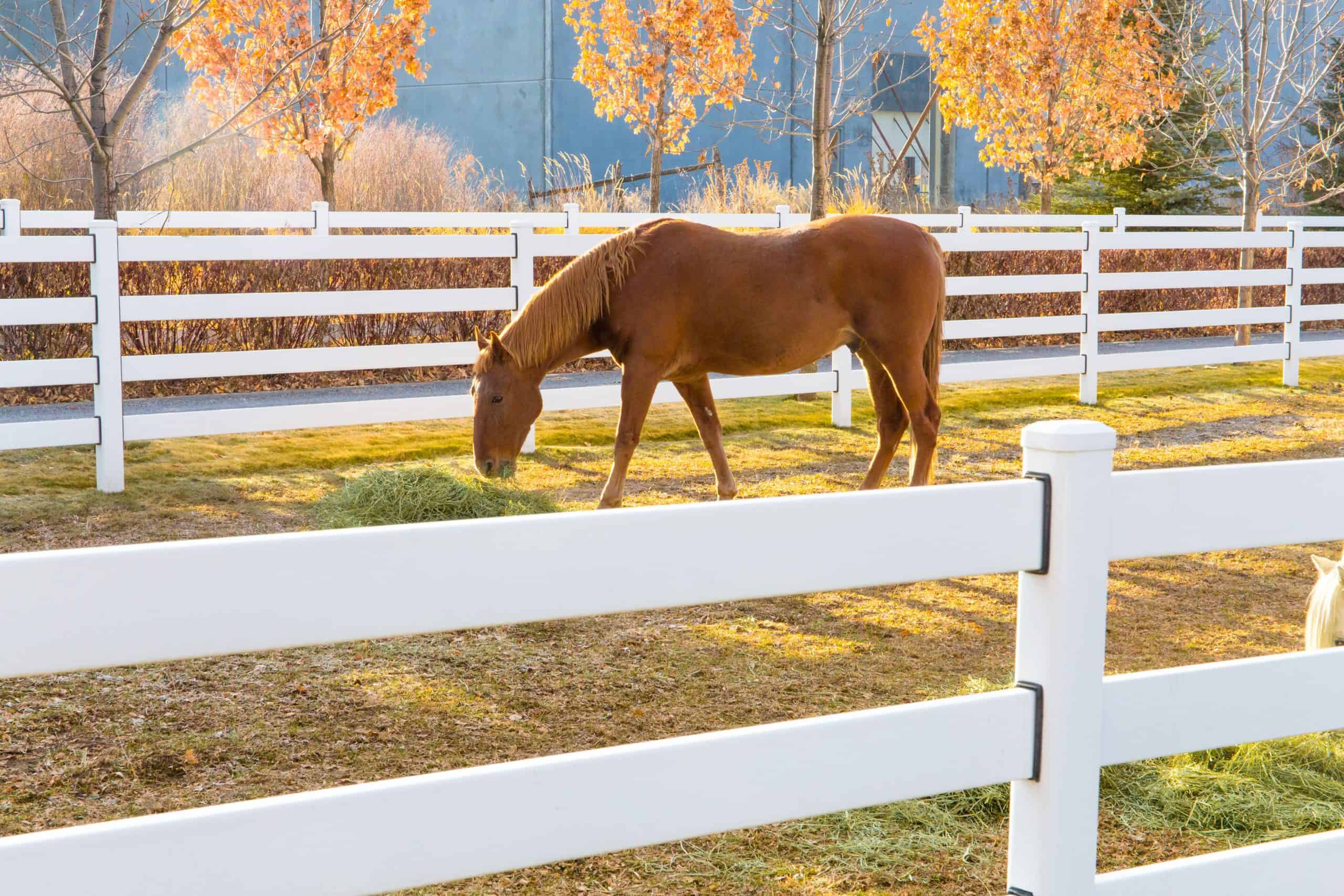Slip board fencing seems straightforward enough—boards that “give” when impacted instead of standing rigid like traditional post-and-rail. The concept makes sense on paper: a horse runs into a fence that moves a bit rather than standing firm, and maybe that horse walks away with less damage.
But is that how it plays out in the real world, where curious horses test every inch of your property line?
We’ve spent decades watching horses interact with every type of fencing imaginable. What we’ve learned is that no decision about horse fencing should be taken lightly. Your animals aren’t just livestock. They’re athletes, companions, and investments worth protecting.
That’s why we need to have an honest conversation about slip board fencing. Not the glossy brochure version, but the mud-on-your-boots reality of what works, what doesn’t, and what might leave you with vet bills you never saw coming. Because at the end of the day, we both want the same thing: horses grazing safely in pastures without you lying awake wondering if your fence will hold through the night.
What Is Slip Board Fencing?
Slip board fencing uses horizontal boards that slide into specially designed slots or brackets on the posts rather than being nailed or screwed directly to them. This creates a system where the boards can move slightly within these slots when pressure is applied.
The design originated from observing how horses interact with fencing. When a horse makes contact with a fence, a rigid system transfers all that force directly to the animal. Slip board systems, however, allow for some movement, potentially reducing the impact.
Most slip board fencing comes in either wood or vinyl versions. Wood offers that classic ranch look many of us prefer, while vinyl provides lower maintenance for busy property owners. The posts typically stand 4-5 feet high with 2-4 horizontal rails depending on your specific containment needs.
Installation demands careful attention to post spacing and depth. Too far apart, and boards may slip out entirely under pressure. Too close, and you’re spending money unnecessarily. Posts need to be set deeper than standard fencing to withstand the different force distribution that happens when boards can move.
What makes slip board fencing different isn’t just the installation method but the whole philosophy behind it. It’s fencing that acknowledges horses will test boundaries and builds in a response to that reality. Whether that response is adequate for your particular horses is what we need to examine more closely.
The Strengths of Slip Board Fencing
The biggest selling point is that “give” factor. When a horse hits traditional rigid fencing at full speed, something’s got to give—and too often, it’s your horse. Slip board systems absorb some of that impact energy by allowing boards to move in their brackets. This can mean the difference between a spooked horse walking away unharmed and one needing serious veterinary attention.
From a maintenance standpoint, there are advantages too. When a board gets damaged—and they will, because horses are essentially 1,200-pound toddlers—you can replace just that single board without dismantling sections of fence. Just slide the damaged board out and the new one in. For busy ranch operations, that time-saving feature matters.
Cost-wise, slip board fencing often sits in the middle range. It’s typically more expensive than basic wire options but less than some of the premium steel systems on the market. For ranchers watching their budgets while still prioritizing safety, this middle-ground position has real appeal.
The flexibility of slip board fencing also means fewer broken posts when impacts do occur. Since the boards can absorb and distribute force differently than fixed systems, the structural components often survive impacts that would crack or split fixed-board fence posts.
Real Concerns for Horse Owners
Before you commit to slip board fencing, you need to know the potential drawbacks that some manufacturers won’t mention in their brochures:
- Weather Vulnerability: Extreme temperatures cause expansion and contraction that can loosen boards over time, creating dangerous gaps or protrusions that catch hooves.
- Curious Testers: Horses are naturally inquisitive and will work at loose boards with their lips and teeth. Some horses quickly learn they can manipulate slip boards to create escape routes.
- Force Limitations: Most slip board systems have specific weight tolerances. A determined 1,200-pound horse leaning consistently on a fence can eventually force boards completely out of their brackets.
- Maintenance Reality: While individual board replacement is easier, you’ll likely be doing it more frequently. The movement that makes these systems safer also accelerates wear on bracket contact points.
- Inconsistent Give: Not all impacts hit the center of a board. When horses impact near post connections, the “give” benefit is significantly reduced, potentially causing the same injuries as fixed fencing.
- UV Degradation: Vinyl slip board systems suffer from brittleness over time in high-sun environments, making them more likely to shatter upon impact rather than flex safely.
- False Security: The perceived safety benefit can lead some owners to install lighter-duty systems than their horses actually require, creating a dangerous mismatch between protection and reality.
- Weight Distribution Issues: Horses that lean or scratch against fencing (a common behavior) can gradually work slip boards into problematic positions, requiring frequent readjustment.
- Ground Clearance Changes: As boards shift and settle, the critical ground clearance measurement can change, potentially creating gaps large enough for a hoof to become trapped.
When Slip Board Makes Sense for Your Ranch
Not every fencing solution works for every situation. Slip board fencing has its place on the right properties with the right horses. Here’s where it might make sense for your operation:
- Slip board fencing works well for gentle horses that respect boundaries once they’re established. If you’ve got animals that aren’t prone to testing fences or leaning heavily against them, the basic protection of slip boards might be sufficient.
- Properties in moderate climates without extreme weather events will get better longevity from slip board systems. The consistent temperatures mean less expansion and contraction that can work boards loose over time.
- For decorative paddocks or areas where horses spend limited time, slip board fencing offers that classic aesthetic without needing the heavy-duty protection required for full-time turnout areas.
A Better Solution
However, after decades of watching horses interact with various fencing systems, we’ve learned that what works on paper doesn’t always hold up in the pasture. That’s why we developed Buckley Steel Board fencing as an alternative that addresses slip board limitations while maintaining its benefits.
Buckley Steel Board takes the core concept of slip board fencing (allowing some movement to reduce injury) but engineers it with precision steel that won’t splinter or shatter. The boards flex under impact but maintain their position during normal horse activity, eliminating that gradual loosening that plagues traditional slip board systems.
Unlike standard slip boards that can be worked loose by determined horses, our steel boards stay secure during daily use but will release under extreme pressure—like when a horse is in true panic. It’s the difference between a fence that gives way when it shouldn’t and one that performs exactly as intended, exactly when needed.
For high-traffic areas, breeding operations, or facilities housing valuable performance horses, the upgrade to Buckley Steel Board provides peace of mind that traditional slip board systems simply can’t match. Your investment is protected without sacrificing the safety features that made slip board appealing in the first place.
Many ranchers find that a strategic combination works best—perhaps traditional slip board fencing for some paddocks, with Buckley Steel Board installed in high-stress areas where horses congregate or along property perimeters where security matters.
Whatever your specific needs, the key is matching your fencing choice to your horses’ behavior and your management style. There’s no one-size-fits-all solution, but there is a right solution for your particular situation.
Fence Right, Sleep Tight
At Buckley Fence, we believe your horses deserve protection that doesn’t compromise. That’s why we developed our Steel Board system to give you the safety benefits of movement under impact without the common failures of traditional slip board systems. It’s fencing that thinks ahead to what your horses might do, not just what you hope they won’t.
Every ranch has different needs, every horse has different habits. We’re here to help you navigate those specifics and find the solution that makes sense for your operation. Because at the end of the day, we’re ranchers too. We understand what’s at stake when you turn your horses out and head in for the night.
Let’s talk about what your horses need. Give us a call to see the difference engineered protection makes. Your horses are counting on you to get this right—and we’re here to make sure you do.



